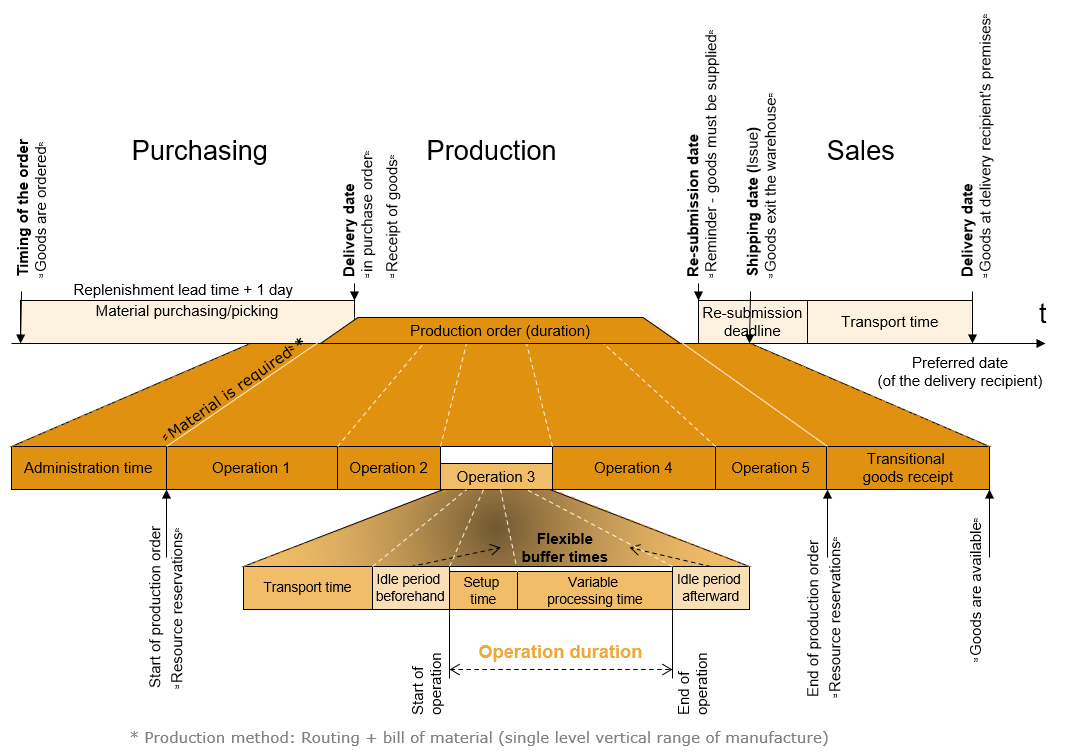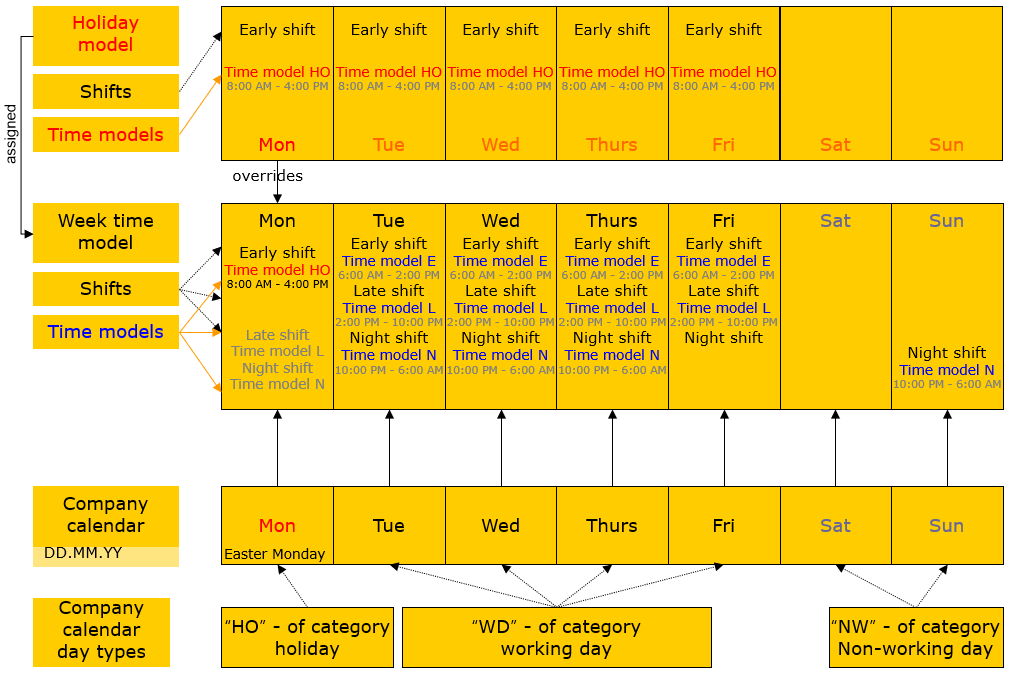Topic overview
This article describes the production-related concepts, such as
- time periods
- time points
- deadlines
It also provides descriptions of basic information for:
- calendars
- time definitions
- as well as references to these terms
Various time points and time periods are relevant during the production run. In addition to variable processing times (such as the actual processing time), which are determined based on specific order quantities, there are fixed times (such as a setup time), which are independent of order quantities. These times are supplemented by idle periods, which can occur as buffer times between production process operations and can be calculated and modified by means of formulas in exactly the same way as processing times and setup times.
Modification is possible according to:
- specific order quantities
- production methods
- variant identifiers
- any parameters
The work-relevant times are mapped via time models in order to define the theoretical capacities of time-dependent resources (means of production, such as equipment, devices, and machines, and persons in the production process). The time models are processed together with the shift definitions for week time models. These processes are handled in the system via dedicated applications: Time models, Shifts, Week time models.
Definition of terms
Administration time
The time that comes before the start of the first operation. No resources are reserved within this time. In principle, the administration time is taken into account one time per production and thus brought to bear only one time during multi-level dispatching. It serves as a preparation of the production order.
Processing time
An operation’s processing time results from the multiplication of the order quantity by the time required for the production of a quantity of 1 (also known as job time).
Holiday model
Holiday models are special week time models that describe the capacity profile for holidays in accordance with the company calendar. Holiday models are assigned to week time models and apply to the weekdays that are Holidays according to the company calendar. If no holiday model is assigned to a week time model, the time model assignments of the corresponding weekday apply. The necessary configuration settings are performed in the Week time models application.
Idle period
The idle period refers to the buffer time between the inbound delivery of the item to be produced at a work center and the commencement of work on the one hand (idle time beforehand) and the execution of the pending operation and the commencement of transport to the next work center on the other (idle time afterward).
Buffer time
A buffer time is a time reserve before or after an operation that allows operations to be postponed or done earlier without missing a deadline. The buffer time includes, for example, an idle period.
Time-specific scheduling
Time-specific scheduling is a process in which the start and end time points of operations are calculated precisely to the millisecond.
Setup time
Setup refers to preparation and follow-up tasks applied to a resource for completing an operation. The setup time is the time required for this. A characteristic of the setup time is that it is fixed, i.e., independent of processing quantity.
Shifts
In conjunction with a time model, a shift describes a specific working period, for instance, early shift from 6:00 am to 2:00 pm. Shifts and time models are specified for each day of the week. Weekdays are grouped into a week time model that represents a capacity profile for resources. The mentioned elements are handled in the corresponding application Shifts, Time models, Week time models.
Shift-specific scheduling
Shift-specific scheduling refers to a process in which operations are assigned to shifts only. The operations that can be carried out in a shift are calculated. The start and end dates are not specified precisely for such operations, rather they are dependent on the selected scheduling category.
Transport time
The transport time refers to the time required to transport goods to the recipient. This may also be the time required to transport material from one work station to another.
Transitional goods receipt
The production item or the co-products of a production order are normally available in the warehouse by the last day of the order. However, the availability may be delayed, for instance, due to quality assurance processes. The delay postpones the point at which the available quantity in the warehouse is increased.
Company calendar
The company calendar is based on a calendar year. Company-specific holidays or regional holidays can be added to the holidays of the calendar year.
Company calendar day category
Every day of a company calendar can be assigned a company calendar day category with the aid of a company calendar day type. Working day, No working day, and Holiday are considered company calendar day categories.
Week time models
Time models and shifts are assigned to each day of a week to produce a week time model. Capacity profiles are specified using week time models. The assignment of a week time model to resources enables the exact capacity and resource availability to be described accurately to the millisecond.
Time models
A time model comprises a precise period of time, for instance, 09:00 to 17:00, independent of the current day. Breaks to be included in the shift are also counted. This precise period of time enables a capacity to be specified for resources or resource groups. Time models and shifts describe a weekday. Weekdays are grouped into a week time model that represents a capacity profile for resources.
Time in production
In addition to the scheduled start and end dates of the production order, other times play a role in the dispatching of production orders.

Additional times are mapped, beginning with the purchasing of materials and extending to the delivery to the delivery recipient. The representation is highly simplified and assumes a one-step production using a bill of material and routing. It follows that the material must be completely available for the first operation and is therefore reserved for this time point.
With its order (sales order) the ordering party specifies a preferred date. The precision of the preferred date can range from a timestamp (milliseconds) up to a year, depending on the due date type. The delivery date is always precise to the day and is calculated from the preferred date of the ordering party. The delivery date is the time point at which the goods must be at the delivery recipient’s premises. A certain time for transport to the delivery recipient, i.e., the transport time, must be planned, if required.
The transport time is also precise to the day. The delivery date, minus the transport time, determines the shipping date. On this date, the goods exit the warehouse. This time point is assigned as a demand date in the planning. A re-submission date can be set in the sales order for the provision of goods for shipping, e.g., for picking.
The material requirements planning (reverse scheduling) calculates the planned target start date based on the production time, if the goods cannot be delivered from the inventory.
The production time is composed of:
- a transitional goods receipt
- the actual production run
- and an administration time preceding the actual production
The actual production run consists of transport times before the operations, buffer times before and after the operation, and the actual duration of the operation. The operation duration consists of a fixed setup time and the variable processing time depending on the production quantity. If the production process requires material that is not completely available in the inventory, purchasing recommendations will be generated by the material requirements planning. The material must be ordered in good time, taking into consideration the replenishment lead time, so that it is available at the start of production.
Working times and resource capacity
The work-relevant times are mapped via time models in order to define the theoretical capacities of time-dependent resources (means of production, such as equipment, devices, and machines, and persons in the production process). The time models are processed together with the shift definitions for week time models.
These week time models describe the capacity profiles available for production on the time axis. By separating the capacity profiles from the actual resources, it is possible to assign the capacity profiles multiple times. As a result, the administrative effort can be reduced.
| Wednesday | Thursday | Friday | |
| Early shift | Time model E (8 hrs) 6:00 AM – 2:00 PM | Time model E (8 hrs) 6:00 AM – 2:00 PM | Time model E (8 hrs) 6:00 AM – 2:00 PM |
| Late shift | Time model L (8 hrs) 2:00 PM – 10:00 PM | Time model L (8 hrs) 2:00 PM – 10:00 PM | Time model L (8 hrs) 2:00 PM – 10:00 PM |
| Night shift | Time model N (8 hrs)
10:00 PM – 6:00 AM |
Time model N (8 hrs)
10:00 PM – 6:00 AM |
Excerpt from a week time model

